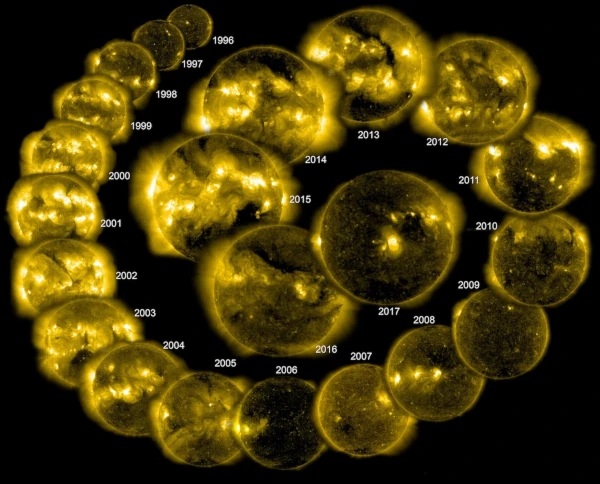
The Sun is a dynamic star whose activity varies according to magnetic cycles of about 11 years, called solar cycles. These cycles generate intense phenomena, notably solar flares, which are sudden releases of magnetic energy in the lower solar corona. These events affect the space environment near Earth and influence space weather.
The solar cycle corresponds to the periodic variation of the Sun's magnetic activity, mainly manifested by the appearance and disappearance of sunspots. This periodicity of about 11 years corresponds to a complete reversal of the solar magnetic field, or a complete magnetic cycle of 22 years.
This dynamic is explained by the dynamo theory, a physical mechanism coupling turbulent convection and the differential rotation of solar plasma to generate and maintain the magnetic field. The alpha-omega model describes this generation:
The fundamental equation governing the evolution of the magnetic field \(\mathbf{B}\) in a conducting fluid is the MHD (magnetohydrodynamic) induction equation: $$ \frac{\partial \mathbf{B}}{\partial t} = \nabla \times (\mathbf{v} \times \mathbf{B}) + \eta \nabla^2 \mathbf{B} $$ where \(\mathbf{v}\) is the plasma velocity and \(\eta\) is the magnetic diffusivity.
Solar flares result from magnetic instability causing a rapid release of magnetic energy stored in the solar corona. This storage occurs through the twisting and shearing of magnetic field lines above sunspots, leading to a non-potential magnetic configuration.
The key physical process is magnetic reconnection, a rapid topological reorganization of field lines that converts magnetic energy into kinetic, thermal, and radiative energy.
Reconnection can be described by the classical Sweet-Parker model or by the faster Petschek model, which is more compatible with observations. The basic equation for reconnection is related to the induction equation with the local effective resistivity increased: \( E = \eta J \) where \(E\) is the induced electric field and \(J\) is the intense current density localized in the reconnection region.
The energy release can reach up to \(10^{25}\) joules in a few minutes, generating emissions across the entire electromagnetic spectrum, from radio waves to X-rays and gamma rays.
A powerful solar flare can, therefore, for a second, approach 1/40th of the total power of the Sun, concentrated locally. This is nearly 3 billion billion kWh. For comparison, the world's annual electricity consumption is about 2.3×1014 kWh. So \(10^{25}\) J represents more than 10,000 times this consumption.
| Parameter | Typical Value | Unit | Reference |
|---|---|---|---|
| Energy Released | \(10^{22}\) to \(10^{25}\) | Joules | Emslie et al. 2012 |
| Duration of the Flare | Minutes to hours | - | Fletcher et al. 2007 |
| Coronal Temperature Reached | 10 to 30 | MK (million K) | Aschwanden 2004 |
| Speed of Coronal Mass Ejections | 100 to 3000 | km/s | Gopalswamy et al. 2009 |
| X-ray Flux | \(10^{-6}\) to \(10^{-3}\) | W/m² (at Earth level) | NOAA Space Weather Prediction Center |
Sources: Emslie et al. (2012), Fletcher et al. (2007), Aschwanden (2004), Gopalswamy et al. (2009), NOAA SWPC.
These phenomena influence the solar wind and can cause geomagnetic storms by disrupting the Earth's magnetosphere, affecting satellites, power grids, and communications.
| Event | Year | Consequences | References |
|---|---|---|---|
| Quebec Blackout | 1989 | Complete power outage for 6 million people for 9 hours. Damaged transformers. | Boteler et al. (1998) |
| Carrington Event | 1859 | Telegraph failures, electric shocks, fires, auroras as far as the tropics. | Cliver & Dietrich (2013) |
| Halloween Storms | 2003 | Satellites disrupted, GPS and communications affected, flights diverted. | Pulkkinen et al. (2005) |
| Missed Eruption of 2012 | 2012 | A Carrington-type CME did not hit Earth but was observed by STEREO-A. | Baker et al. (2013) |
| GPS WAAS Failure | 2011 | GPS augmentation service interrupted for several hours, affecting air navigation. | NOAA SWPC |